Hi, I would like to generate a temperature anomalies graph with a trend line which looks almost like this:
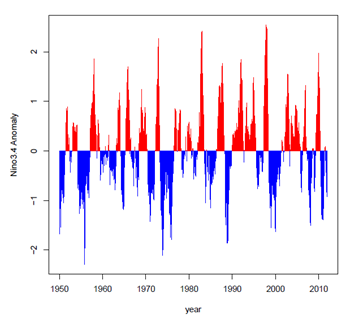
This is my reprex:
library(ggplot2)
library(lubridate)
library(tidyverse)
df <- data.frame(stringsAsFactors = FALSE,
Date = c(1981, 1982, 1983, 1984, 1985, 1986, 1987, 1988, 1989, 1990, 1991, 1992, 1993,
1994, 1995, 1996, 1997, 1998, 1999, 2000, 2001, 2002, 2003, 2004, 2005, 2006,
2007, 2008, 2009, 2010, 2011, 2012, 2013, 2014, 2015, 2016, 2017),
Temp = c(-0.2, -0.1, -0.2, -0.7, -0.3, -0.4, -0.7, -0.8, -0.8, -0.2, 0.2, -0.4, 0.1,
-0.1, 0.2, -0.1, 0.4, 0.5, 1.0, 0.2, 0.2, 0.2, 0.1, -0.6, 0.6, 0.6,
0.2, 0.2, 0.5, 0.2, 0.3, 0.3, 0.2, 0.4, 0.0, 0.6, 0.5))
df %>%
mutate(Date = dmy(paste("01-01-", Date))) %>%
ggplot(aes(x = Date, y = Temp)) +
geom_line() + geom_area(colour = "red",size = 1)+theme_bw()+
scale_x_date(date_labels = "%Y",
date_breaks = "1 year",
minor_breaks = "1 year") +
theme_minimal() +
theme(axis.text.x = element_text(angle=45, hjust=1, vjust = 1))
I have the following graph:
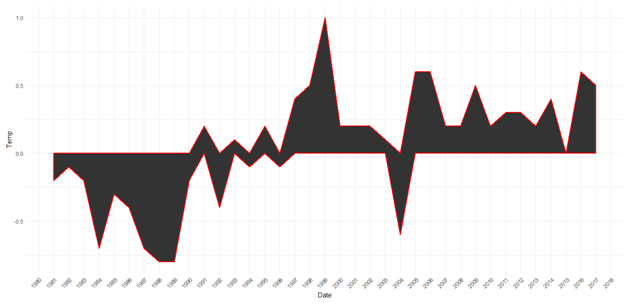
I need some help with this. Thanks
If you're OK with base R solution, here you go:
df <- data.frame(Date = c(1981, 1982, 1983, 1984, 1985, 1986, 1987, 1988, 1989, 1990, 1991, 1992, 1993,
1994, 1995, 1996, 1997, 1998, 1999, 2000, 2001, 2002, 2003, 2004, 2005, 2006,
2007, 2008, 2009, 2010, 2011, 2012, 2013, 2014, 2015, 2016, 2017),
Temp = c(-0.2, -0.1, -0.2, -0.7, -0.3, -0.4, -0.7, -0.8, -0.8, -0.2, 0.2, -0.4, 0.1,
-0.1, 0.2, -0.1, 0.4, 0.5, 1.0, 0.2, 0.2, 0.2, 0.1, -0.6, 0.6, 0.6,
0.2, 0.2, 0.5, 0.2, 0.3, 0.3, 0.2, 0.4, 0.0, 0.6, 0.5))
with(data = df,
expr = {
plot(x = Date,
y = Temp,
pch = NA_integer_)
polygon(x = c(min(Date), Date, max(Date)),
y = c(0, Temp, 0),
col = "red")
clip(x1 = min(Date),
x2 = max(Date),
y1 = min(Temp),
y2 = 0)
polygon(x = c(min(Date), Date, max(Date)),
y = c(0, Temp, 0),
col = "blue")
})
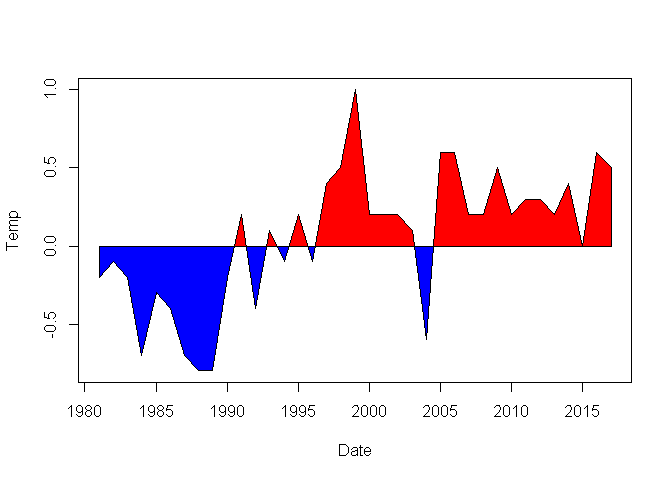
Created on 2019-05-01 by the reprex package (v0.2.1)
Hope this helps.
Thanks a lot Yanakabrina. This is the right graph I want. Is it possible to include a trend line as well?. Its my first time hearing about Base R solutions but I will do some reading.
Well, my username is Yarnabrina ![]()
Can you please elaborate? Do you want something like geom_smooth? In that case, you can do something like the following. This can be made better, but I don't know much about loess.
df <- data.frame(Date = c(1981, 1982, 1983, 1984, 1985, 1986, 1987, 1988, 1989, 1990,
1991, 1992, 1993, 1994, 1995, 1996, 1997, 1998, 1999, 2000,
2001, 2002, 2003, 2004, 2005, 2006, 2007, 2008, 2009, 2010,
2011, 2012, 2013, 2014, 2015, 2016, 2017),
Temp = c(-0.2, -0.1, -0.2, -0.7, -0.3, -0.4, -0.7, -0.8, -0.8, -0.2,
0.2, -0.4, 0.1, -0.1, 0.2, -0.1, 0.4, 0.5, 1.0, 0.2,
0.2, 0.2, 0.1, -0.6, 0.6, 0.6, 0.2, 0.2, 0.5, 0.2,
0.3, 0.3, 0.2, 0.4, 0.0, 0.6, 0.5))
with(data = df,
expr = {
plot(x = Date,
y = Temp,
pch = NA_integer_)
polygon(x = c(min(Date), Date, max(Date)),
y = c(0, Temp, 0),
col = "red")
usr <- par("usr")
clip(x1 = min(Date),
x2 = max(Date),
y1 = min(Temp),
y2 = 0)
polygon(x = c(min(Date), Date, max(Date)),
y = c(0, Temp, 0),
col = "blue")
do.call(what = clip,
args = as.list(x = usr))
lines(x = loess.smooth(x = Date,
y = Temp,
span = 0.25),
col = "green",
lwd = 2)
})
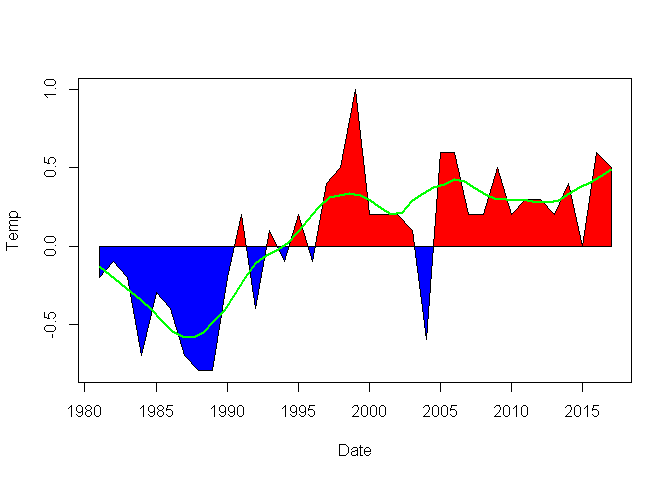
For a ggplot solution, you might want to look at this SO post. You'll have to change this for your own data, of course.
This is a tidyverse based solution, is this what you are trying to do?
library(tidyverse)
library(lubridate)
df <- data.frame(stringsAsFactors = FALSE,
Date = c(1981, 1982, 1983, 1984, 1985, 1986, 1987, 1988, 1989, 1990, 1991, 1992, 1993,
1994, 1995, 1996, 1997, 1998, 1999, 2000, 2001, 2002, 2003, 2004, 2005, 2006,
2007, 2008, 2009, 2010, 2011, 2012, 2013, 2014, 2015, 2016, 2017),
Temp = c(-0.2, -0.1, -0.2, -0.7, -0.3, -0.4, -0.7, -0.8, -0.8, -0.2, 0.2, -0.4, 0.1,
-0.1, 0.2, -0.1, 0.4, 0.5, 1.0, 0.2, 0.2, 0.2, 0.1, -0.6, 0.6, 0.6,
0.2, 0.2, 0.5, 0.2, 0.3, 0.3, 0.2, 0.4, 0.0, 0.6, 0.5))
df %>%
mutate(Date = dmy(paste("01-01-", Date)),
Sign = if_else(Temp >= 0, "Positive", "Negative")) %>%
ggplot(aes(x = Date, y = Temp)) +
geom_area(aes(fill = Sign), show.legend = FALSE) +
geom_smooth(method = "lm", se = FALSE) +
theme_bw() +
scale_x_date(date_labels = "%Y",
date_breaks = "1 year",
minor_breaks = "1 year") +
theme_minimal() +
theme(axis.text.x = element_text(angle=45, hjust=1, vjust = 1))

Thanks again, this is helpful
Thanks again Andres, this will work for me.
Hi Andres, I realize the polygons overlap between 1991 - 2004 showing both positive and negative values for the years yet each year is to have either a positive or negative value. Can there be a work around this? Thanks
Yeah, I noticed later, I'm thinkng about a solution but I haven't came up with one yet, you can go with Yarnabrina's base R solution, if I figure out a correct ggplot2 solution I will post it later.
Here's a result of shameless copy-paste from the SO thread I mentioned, and hence full credit goes to Henrik, and recursively to kohske.
df <- data.frame(Date = c(1981, 1982, 1983, 1984, 1985, 1986, 1987, 1988, 1989, 1990,
1991, 1992, 1993, 1994, 1995, 1996, 1997, 1998, 1999, 2000,
2001, 2002, 2003, 2004, 2005, 2006, 2007, 2008, 2009, 2010,
2011, 2012, 2013, 2014, 2015, 2016, 2017),
Temp = c(-0.2, -0.1, -0.2, -0.7, -0.3, -0.4, -0.7, -0.8, -0.8, -0.2,
0.2, -0.4, 0.1, -0.1, 0.2, -0.1, 0.4, 0.5, 1.0, 0.2,
0.2, 0.2, 0.1, -0.6, 0.6, 0.6, 0.2, 0.2, 0.5, 0.2,
0.3, 0.3, 0.2, 0.4, 0.0, 0.6, 0.5))
df$grp <- "orig"
new_df <- do.call(what = "rbind",
args = sapply(X = 1:(nrow(x = df) -1),
FUN = function(i)
{
f <- lm(formula = (Date ~ Temp),
data = df[i:(i + 1),])
if (f$qr$rank < 2)
{
return(NULL)
}
r <- predict(object = f,
newdata = data.frame(Temp = 0))
if(df[i,]$Date < r & r < df[i+1,]$Date)
{
return(data.frame(Date = r,
Temp = 0))
} else
{
return(NULL)
}
}))
new_df$grp <- "new"
df_mod <- rbind(df, new_df)
library(ggplot2)
#> Registered S3 methods overwritten by 'ggplot2':
#> method from
#> [.quosures rlang
#> c.quosures rlang
#> print.quosures rlang
ggplot(data = df_mod,
mapping = aes(x = Date,
y = Temp)) +
geom_area(data = subset(x = df_mod,
subset = (Temp <= 0)),
fill = "red") +
geom_area(data = subset(x = df_mod,
subset = (Temp >= 0)),
fill = "blue") +
geom_smooth(se = FALSE,
colour = "green")
#> `geom_smooth()` using method = 'loess' and formula 'y ~ x'

Created on 2019-05-01 by the reprex package (v0.2.1)
Great thanks once again Yarnabrina for your help. This is a nice graph as well with ggplot. Thank you guys for your effort.
I figured out a simple but not exact or generalizable solution (intersecting values are not exact but I think they are good enough for visualization purposes)
intersection <- df %>%
mutate(Date = dmy(paste("01-01-", Date))) %>%
mutate(sign_change = Temp/lead(Temp) < 0) %>%
filter(sign_change == TRUE) %>%
mutate(Date = Date + months(6),
Positive = 0,
Negative = 0) %>%
select(-sign_change)
df %>%
mutate(Date = dmy(paste("01-01-", Date)),
Positive = ifelse(Temp >= 0, Temp, 0),
Negative = ifelse(Temp < 0, Temp, 0)) %>%
bind_rows(intersection) %>%
gather(Sign, Temp, -Date, -Temp) %>%
ggplot(aes(x = Date, y = Temp)) +
geom_area(aes(fill = Sign), show.legend = FALSE, position = "identity") +
geom_smooth(se = FALSE) +
theme_bw() +
scale_x_date(date_labels = "%Y",
date_breaks = "1 year",
minor_breaks = "1 year",
expand = c(0,0)) +
theme_minimal() +
theme(axis.text.x = element_text(angle=45, hjust=1, vjust = 1))
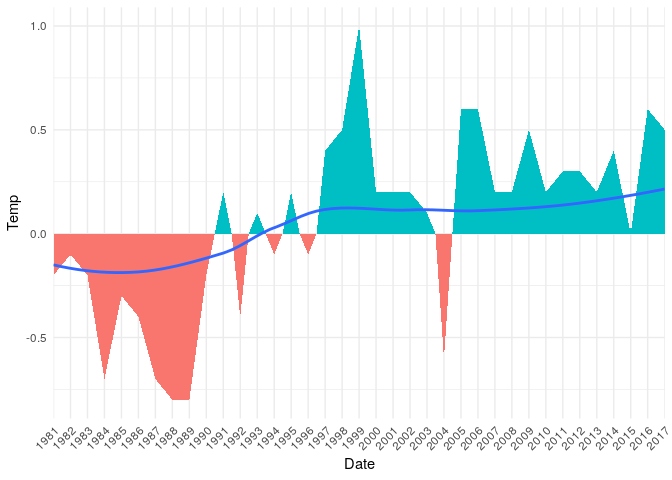
Thanks a lot Andres, this is great work. Thanks for the effort put in
This topic was automatically closed 7 days after the last reply. New replies are no longer allowed.
If you have a query related to it or one of the replies, start a new topic and refer back with a link.